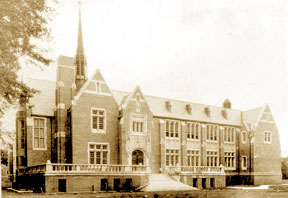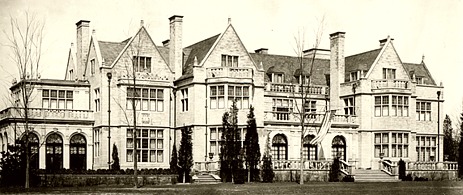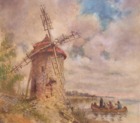|
Postwar Growth: From the late 1940s until 1970, the community saw a major increase in population. Demand for land and cost of upkeep resulted in the first demolition of mansions along the lake. The neoclassical David Whitney House was gone by 1956. The John Newberry House was replaced by Newberry Place in 1957 and Henry B. Joy's House by the Fairacres Subdivision in 1959. Inland, remaining vacant lots were quickly occupied by new homes. Ending a five year construction moratorium in Grosse Pointe Woods, the huge Grosse-Gratiot Drain Project, approved by voters in 1958, provided the infrastructure required for previously planned residential developments.

In the face of postwar expansion, only Grosse Pointe Shores remained a village. Grosse Pointe Farms became a city in 1949; Grosse Pointe Park and Woods followed in 1950. The latter year also saw the charter of a local League of Women Voters and the relocation of the Children's Home of Detroit to Cook Road. Anticipating the opening of Eastland Shopping Center, nearby Harper Woods incorporated in 1951. The Korean War (1950 -1953) resulted in the addition of 105 veterans' names to the plaque at the War Memorial; of these, 33 died in combat. In 1953 the Grosse Pointe Symphony was founded and in 1954, the Foundation for Exceptional Children.
Obtaining full parish status in 1947, Christ Church, Grosse Pointe established its own mission, St. Michael's, in Grosse Pointe Woods. Numerous other parishes constructed new sanctuaries: St. James Lutheran in 1948, Grosse Pointe Methodist in 1950, Grosse Pointe Baptist in 1955 and Grosse Pointe Unitarian in 1965. The 1955 opening of Our Lady Star of the Sea Catholic Church in Grosse Pointe Woods obliged some members of St. Paul's Catholic Church to transfer to the new parish.
Increased public school enrollment prompted new construction. In addition to middle schools, Parcells in 1948 and Brownell in 1958, elementary schools -- Poupard in 1951, Ferry in 1954 and Barnes in 1956 -- were built to serve a growing enrollment in Grosse Pointe Woods. With an additional 400 students enrolled each year in the 1960s, the community soon needed a second high school. Built on Vanderbush property (one of the last working farms in the Pointes), North High School opened in 1968; its first senior class graduated in 1970.
Changes also occurred at local private schools. In 1954, Grosse Pointe Country Day and Detroit University Schools combined to form the co-educational Grosse Pointe University School (GPUS). The world renowned architect Minoru Yamasaki was hired to enlarge the Cook Road campus. After the public school system purchased Country Day's Grosse Pointe Boulevard buildings, the former headmaster's house became the superintendent's home until its sale in 1990. Meanwhile, Liggett School, founded in 1878, moved from Detroit to a new Grosse Pointe Woods campus in 1966. In 1969, it merged with GPUS to form University Liggett School.
In June of that year, the historic day/boarding school at the Convent of the Sacred Heart closed. However, by the autumn, community leaders had created a replacement, The Grosse Pointe Academy, with co-educational day classes for pre-school through eighth grade.
The generosity of local residents, evident since the early days, continued. Contributions from citizens enabled construction of Marcel Breuer's Grosse Pointe Library - Fisher Branch in 1953, the War Memorial's Fries Auditorium in 1961, Ellsworthy Field in 1965 and the replacement for the unstable Neighborhood Club building in 1966. Major gifts also helped to develop or improve the various municipal parks.
Challenges of the 1960s and 1970s: Grosse Pointers in these decades faced conflict in all facets of life. There were debates over racial injustice, the Vietnam War, illegal drugs and family values.  To deal with these problems, citizens founded new agencies like the Northeast Guidance Center in 1963, Family Life Education Council (FLEC) in 1966 and Grosse Pointe Interfaith Center for Racial Justice in 1967. In March 1968, three weeks before his assassination, the Human Rights Council sponsored a speech by Dr. Martin Luther King at Grosse Pointe High School. From 1970 to 1979, community police departments organized the interdepartmental Youth Services Bureau to serve local young people with problems. To deal with these problems, citizens founded new agencies like the Northeast Guidance Center in 1963, Family Life Education Council (FLEC) in 1966 and Grosse Pointe Interfaith Center for Racial Justice in 1967. In March 1968, three weeks before his assassination, the Human Rights Council sponsored a speech by Dr. Martin Luther King at Grosse Pointe High School. From 1970 to 1979, community police departments organized the interdepartmental Youth Services Bureau to serve local young people with problems.
During the 1970s, many enterprises grew, even as population declined for the first time in thirty years. Hospitals -- Cottage in 1971 and Bon Secours in 1975 -- completed major additions. Grosse Pointe South High School, so named in 1969, added a Grosse Pointe Boulevard Wing in 1973. The next year, Jacobson's, in The Village since 1943, expanded to cover an entire city block. In the process, buildings housing well-known businesses such as the Treasure Chest Toy Store and Notre Dame Pharmacy were demolished.
Other changes, both man-made and natural, also occurred. In 1971, SEMTA, the regional Southeast Michigan Transportation Authority, took over public transit from the Lake Shore Coach Line. Two major spring storms in 1973 combined with the highest lake levels in over one hundred years to create extensive flooding. By 1977, fuel prices had skyrocketed, giving a new meaning to energy conservation. Restoration after a major fire at St. Paul Catholic Church on June 9, 1978 forced parishioners to worship elsewhere. With demand for new housing continuing, subdivisions replaced large estates such as the Schlotman's Stonehurst in 1974 and Mrs. Horace Dodge's Rose Terrace in 1978. Only the Edsel Ford House was spared when Mrs. Ford, in her 1978 bequest, provided an endowment for its preservation and public use.

|



